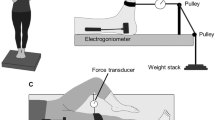Abstract
How humans maintain balance and change postural control due to age, injury, immobility or training is one of the basic questions in motor control. One of the problems in understanding postural control is the large set of degrees of freedom in the human motor system. Therefore, a self-organizing map (SOM), a type of artificial neural network, was used in the present study to extract and visualize information about high-dimensional balance strategies before and after a 6-week slackline training intervention. Thirteen subjects performed a flamingo and slackline balance task before and after the training while full body kinematics were measured. Range of motion, velocity and frequency of the center of mass and joint angles from the pelvis, trunk and lower leg (45 variables) were calculated and subsequently analyzed with an SOM. Subjects increased their standing time significantly on the flamingo (average +2.93 s, Cohen’s d = 1.04) and slackline (+9.55 s, d = 3.28) tasks, but the effect size was more than three times larger in the slackline. The SOM analysis, followed by a k-means clustering and marginal homogeneity test, showed that the balance coordination pattern was significantly different between pre- and post-test for the slackline task only (χ 2 = 82.247; p < 0.001). The shift in balance coordination on the slackline could be characterized by an increase in range of motion and a decrease in velocity and frequency in nearly all degrees of freedom simultaneously. The observation of low transfer of coordination strategies to the flamingo task adds further evidence for the task-specificity principle of balance training, meaning that slackline training alone will be insufficient to increase postural control in other challenging situations.





Similar content being viewed by others
References
Bartlett RM, Lamb PF, O’Donovan D, Kennedy G (2014) Use of self-organizing maps for exploring coordination variability in the transition between walking and running. Int J Comp Psychol 27:123–137. doi:10.5811/westjem.2011.5.6700
Barton G, Lees A, Lisboa P, Attfield S (2006) Visualisation of gait data with Kohonen self-organising neural maps. Gait Posture 24:46–53. doi:10.1016/j.gaitpost.2005.07.005
Barton G, Lisboa P, Lees A, Attfield S (2007) Gait quality assessment using self-organising artificial neural networks. Gait Posture 25:374–379. doi:10.1016/j.gaitpost.2006.05.003
Barton GJ, Hawken MB, Scott MA, Schwartz MH (2012) Movement deviation profile: a measure of distance from normality using a self-organizing neural network. Hum Mov Sci 31:284–294. doi:10.1016/j.humov.2010.06.003
Carpenter MG, Murnaghan CD, Inglis JT (2010) Shifting the balance: evidence of an exploratory role for postural sway. Neuroscience 171:196–204. doi:10.1016/j.neuroscience.2010.08.030
Davies DL, Bouldin DW (1979) A cluster separation measure. IEEE Trans Pattern Anal Mach Intell 1:224–227. doi:10.1109/TPAMI.1979.4766909
de Leva P (1996) Adjustments to Zatiorsky–Seluyanov’s segment inertia parameters. J Biomech 29:1223–1230
Donath L, Roth R, Rueegge A et al (2013) Effects of slackline training on balance, jump performance & muscle activity in young children. Int J Sports Med 34:1093–1098. doi:10.1055/s-0033-1337949
Donath L, Roth R, Zahner L, Faude O (2016) Slackline training and neuromuscular performance in seniors: a randomized controlled trial. Scand J Med Sci Sport 26:275–283. doi:10.1111/sms.12423
Donath L, Roth R, Zahner L, Faude O (2017) Slackline training (balancing over narrow nylon ribbons) and balance performance: a meta-analytical review. Sport Med 47:1075–1086. doi:10.1007/s40279-016-0631-9
Gabel CP, Coast S, Beach C (2013) Slacklining for lower extremity rehabilitation and injury prevention. Int J Athl Ther Train 18:14–19
Gabel CP, Osborne J, Burkett B (2015) The influence of “Slacklining” on quadriceps rehabilitation, activation and intensity. J Sci Med Sport 18:62–66. doi:10.1016/j.jsams.2013.11.007
Giboin LS, Gruber M, Kramer A (2015) Task-specificity of balance training. Hum Mov Sci 44:22–31. doi:10.1016/j.humov.2015.08.012
Granacher U, Iten N, Roth R, Gollhofer A (2010) Slackline training for balance and strength promotion. Int J Sports Med 31:717–723. doi:10.1055/s-0030-1261936
Honegger F, Tielkens RJM, Allum JHJ (2013) Movement strategies and sensory reweighting in tandem stance: differences between trained tightrope walkers and untrained subjects. Neuroscience 254:285–300. doi:10.1016/j.neuroscience.2013.09.041
Hüfner K, Binetti C, Hamilton DA et al (2011) Structural and functional plasticity of the hippocampal formation in professional dancers and slackliners. Hippocampus 21:855–865. doi:10.1002/hipo.20801
Keller M, Pfusterschmied J, Buchecker M et al (2012) Improved postural control after slackline training is accompanied by reduced H-reflexes. Scand J Med Sci Sports 22:471–477. doi:10.1111/j.1600-0838.2010.01268.x
Kohonen T (2001) Self-organizing maps, 3rd edn. Springer, Berlin
Kümmel J, Kramer A, Giboin L-S, Gruber M (2016) Specificity of balance training in healthy individuals: a systematic review and meta-analysis. Sport Med 46:1261–1271. doi:10.1007/s40279-016-0515-z
Lamb PF (2012) Understanding the relationship among launch variables in the golf drive using neural network visualisations. Sport Biomech 11:249–261. doi:10.1080/14763141.2011.638389
Lamb PF, Mündermann A, Bartlett RM, Robins A (2011) Visualizing changes in lower body coordination with different types of foot orthoses using self-organizing maps (SOM). Gait Posture 34:485–489. doi:10.1016/j.gaitpost.2011.06.024
Lamb PF, Bartlett RM, Lindinger S, Kennedy G (2014) Multi-dimensional coordination in cross-country skiing analyzed using self-organizing maps. Hum Mov Sci 33:54–69. doi:10.1016/j.humov.2013.08.005
Magon S, Donath L, Gaetano L et al (2016) Striatal functional connectivity changes following specific balance training in elderly people: MRI results of a randomized controlled pilot study. Gait Posture 49:334–339. doi:10.1016/j.gaitpost.2016.07.016
Milosevic M, McConville KMV, Sejdic E et al (2012) Visualization of trunk muscle synergies during sitting perturbations using Self-Organizing Maps (SOM). IEEE Trans Biomed Eng 59:2516–2523. doi:10.1109/TBME.2012.2205577
Paoletti P, Mahadevan L (2012) Balancing on tightropes and slacklines. J R Soc Interface 9:2097–2108. doi:10.1098/rsif.2012.0077
Peterka RJ (2002) Sensorimotor integration in human postural control. J Neurophysiol 88:1097–1118
Pfusterschmied J, Buchecker M, Keller M et al (2013) Supervised slackline training improves postural stability. Eur J Sport Sci 13:49–57
Serrien B, Clijsen R, Anders S et al (2016) Intra-seasonal variability of ball speed and coordination of two team-handball throwing techniques in elite male adolescent players. Int J Comput Sci Sport 15:1–29. doi:10.1515/ijcss-2016-0001
Stepan G (2009) Delay effects in the human sensory system during balancing. Philos Trans R Soc A 367:1195–1212. doi:10.1098/rsta.2008.0278
Stepan G, Kollar L (2000) Balancing with reflex delay. Math Comput Model 31:199–205. doi:10.1016/S0895-7177(00)00039-X
van Diest M, Stegenga J, Wörtche HJ et al (2015) Quantifying postural control during exergaming using multivariate whole-body movement data: a self-organizing maps approach. PLoS ONE. doi:10.1371/journal.pone.0134350
Vesanto J, Himberg J, Alhoniemi E, Parhankangas J (2000) SOM toolbox for Matlab 5
Wu G, Siegler S, Allard P et al (2002) ISB recommendation on definitions of joint coordinate system of various joints for the reporting of human joint motion—part I: ankle, hip and spine. J Biomech 35:543–548. doi:10.1006/rtph.2002.1549
Wu G, van der Helm FCT, Veeger HEJDJ et al (2005) ISB recommendation on definitions of joint coordinate systems of various joints for the reporting of human joint motion—Part II: shoulder, elbow, wrist and hand. J Biomech 38:981–992. doi:10.1016/j.jbiomech.2004.05.042
Acknowledgements
We like to thank Medi-Lines for providing the Slackbase free of charge to conduct the experiments and the training, and Thomas Konzett for assisting at the measurements.
Author information
Authors and Affiliations
Corresponding author
Ethics declarations
Conflict of interest
All authors declare that they have no conflict of interest that may have biased the findings in this article.
Electronic supplementary material
Below is the link to the electronic supplementary material.
Rights and permissions
About this article
Cite this article
Serrien, B., Hohenauer, E., Clijsen, R. et al. Changes in balance coordination and transfer to an unlearned balance task after slackline training: a self-organizing map analysis. Exp Brain Res 235, 3427–3436 (2017). https://doi.org/10.1007/s00221-017-5072-7
Received:
Accepted:
Published:
Issue Date:
DOI: https://doi.org/10.1007/s00221-017-5072-7




